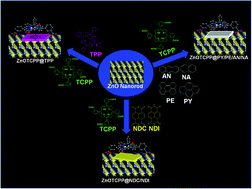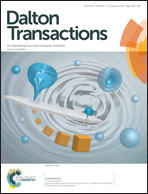Selectively recognizing organic semiconducting molecules on solid state molecular cages based on ZnOTCPP†
Abstract
In this study, we constructed a novel solid state supramolecular system—the molecular cage ZnOTCPP, based on an inorganic/organic hybrid nanostructure, through the assembly of 5,10,15,20-tetra(3-carboxyphenyl)porphyrin (TCPP) onto the surfaces of ZnO nanorod (NR) arrays. The ZnOTCPP molecular cage exhibited highly selective recognition of 5,10,15,20-tetraphenylporphyrin (TPP) by optical and photoelectrical signals. The ZnOTCPP@TPP exhibited high emission efficiency, with a six-fold increase in the intensity of the emission relative to that of ZnOTCPP after the molecular cage ZnOTCPP captured TPP. The optical, electrical, and optoelectrical properties of the molecular cage ZnOTCPP could be controlled by tuning the interactions between the guest and the host's inorganic or organic moieties. Such a solid state molecular cage opens the door to controlled-delivery applications and provides an attractive platform for studying solid state supramolecular electronics and optoelectronics.


 Please wait while we load your content...
Please wait while we load your content...